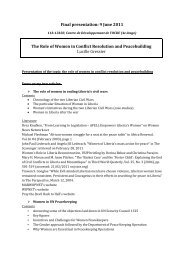Women's Economic Opportunity Index - Economist Intelligence Unit
Women's Economic Opportunity Index - Economist Intelligence Unit
Women's Economic Opportunity Index - Economist Intelligence Unit
- No tags were found...
Create successful ePaper yourself
Turn your PDF publications into a flip-book with our unique Google optimized e-Paper software.
Appendix IWomen’s economic opportunityA new global index and rankingdownsizing, mandatory early retirements were widely applied to employees who were within five yearsof the legal retirement age. This resulted in large numbers of women in their late 40s being laid off, andsubsequently having a much more difficult time than men in becoming re-employed. 52 Analysis showedthat on average women were unemployed for nearly 22 months longer than male workers laid off at thesame time. When researchers estimated the extent to which the predicted gender gap in unemploymentduration could be attributed to either differences in observable characteristics or differences in regressioncoefficients, 53 it was found that given the same market structure, women’s predicted mean unemploymentperiod would be 7.7 months shorter than men’s. In other words, women’s search efforts were hamperedby a lack of access to social networks, higher costs of job separation (in terms of decreased earnings),unequal entitlement to re-employment services and unfair treatment with respect to mandatoryretirement.Further ReadingJ Falkingham and K Rake, “Modelling the Gender Impact of British Pension Reforms”, in J Ginn, D Streetand S Arber (eds.), Women, Work and Pensions—International Issues and Prospects, Buckingham: OpenUniversity Press, 2001.E James, A Cox Edwards and R Wong, “The gender impact of pension reform: a cross-country analysis”,World Bank Policy Research Working Paper Series 3074, World Bank: Washington DC, 2003. http://ideas.repec.org/s/wbk/wbrwps.htmlA Munnell and N Jivan, “What Makes Older Women Work?”, Issue Brief, Series 1, Boston College, Centrefor Retirement Research: Boston MA, 2005.2) Access to Finance52. F Du and X Dong, “Why DoWomen Have Longer Durationsof Unemployment than Menin Post-Restructuring UrbanChina?”, Cambridge Journal of<strong>Economic</strong>s, Vol. 33, Issue 2, 2009pages 233-252.53. ibid. The regressioncoefficients included humancapital characteristics,marital status and householddemographics, re-employmentincentives, ownership of thefirm employed before lay-off,access to social networks, andmacroeconomic indicators.54. J F Houston, C Lin, P Linand Y Ma, “Creditor Rights,Information Sharing, andBank Risk Taking”, Journal ofFinancial <strong>Economic</strong>s, Vol. 96,Issue 3, 2010. doi:10.1016/j.jfineco.2010.02.008Building credit historiesThe <strong>Index</strong> looks at two basic building blocks of women’s access to finance: credit and savings. Theability to deposit savings safely in a financial institution and to take loans out to finance businessesis particularly important for women entrepreneurs. It is important to note that there are no globallyavailable sex-disaggregated data on women’s access to finance. Hence, the following indicators are notbased on gender-disaggregated quantitative data, but were selected because of the potential impact thatreform in these areas may have on women’s employment and business opportunities. We hope that thisindexing effort will spur further research in this important area.Building credit histories measures the coverage, scope, quality and accessibility of credit informationthat is available through public and private credit registries. It is disaggregated from data collected by theWorld Bank Group’s Doing Business project. Although a credit history is not a substitute for risk analysis,banks that share credit information make it easier for loan officers to assess borrowers’ creditworthinessusing objective measures. If lenders are also reassured by strong creditors’ rights, it allows them to takegreater, better-informed risks. 54112 <strong>Economist</strong> <strong>Intelligence</strong> <strong>Unit</strong> 2010




